Conan Gallaty took over for the long-serving Paul Tash as the Tampa Bay Times’ CEO in mid-January and will succeed Tash as board chair of the Times Publishing Co. on July 1. Gallaty, who became president of the Times in 2020, will be just the fourth person to lead it since legendary publisher Nelson Poynter’s death in 1978.
The 46-year-old Gallaty joined the Times after a 20-year career focused on digital media. He graduated with a journalism degree from The University of Georgia and started as a reporter at his hometown newspaper in Rome, Ga., learning over time to serve readers in new ways. During his tenure at the Times, he upgraded tampabay.com and spearheaded growth in digital advertising and subscriptions.
The Poynter Institute for Media Studies owns the Times and, as the newspaper’s business model declined, financial peril forced it to lay off employees, impose pay cuts and furloughs, and cede its pension plan to the federal government. Today, the Times is profitable, including on a net operating basis, Gallaty said.
In 2020, as the Covid-19 pandemic crushed revenues, the paper reduced printing from seven days a week to only two: Wednesdays and Sundays. In 2021, the paper outsourced printing and sold its local plant. It publishes a digital e-Newspaper seven days a week as well as more than a dozen newsletters. Its website provides 24/7 digital access to the news.
Gallaty acknowledges that it’s very unlikely the Times would resume printing more editions, and understands some readers remain disappointed with the change. The Times’ experience holds lessons for publishers transitioning reluctant subscribers from print to digital and increasing retention by making the content a habit for them.
Frequency of visit, Gallaty said, is his “North Star.” Following is an edited transcript of an interview of Gallaty by Greg Burns of the Medill Local News Initiative.

